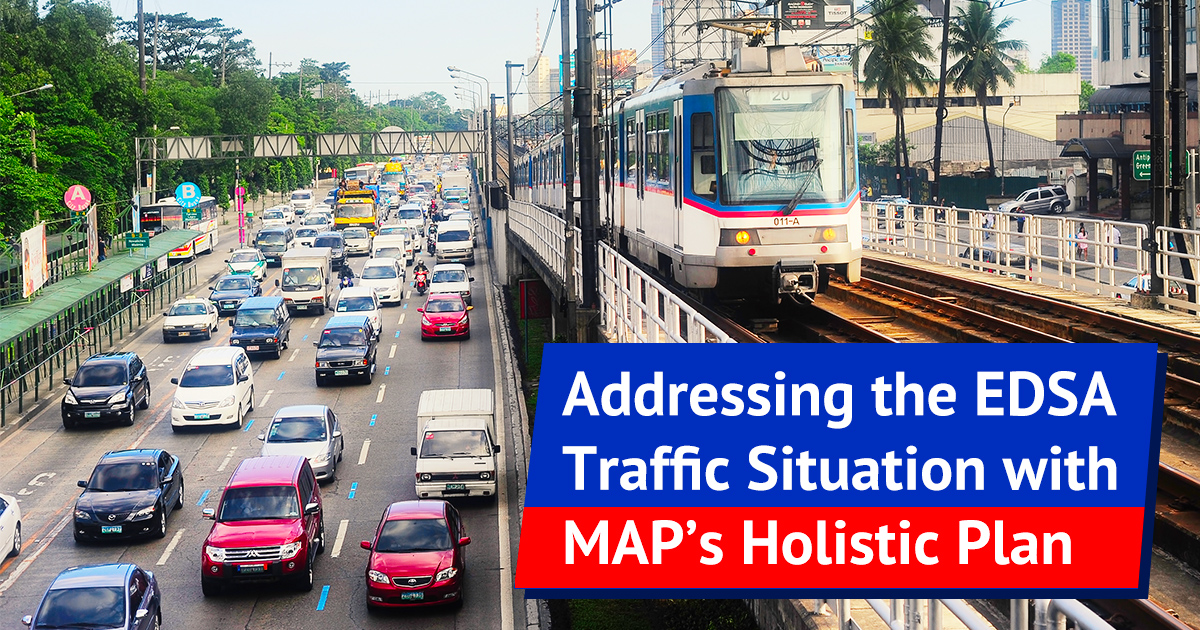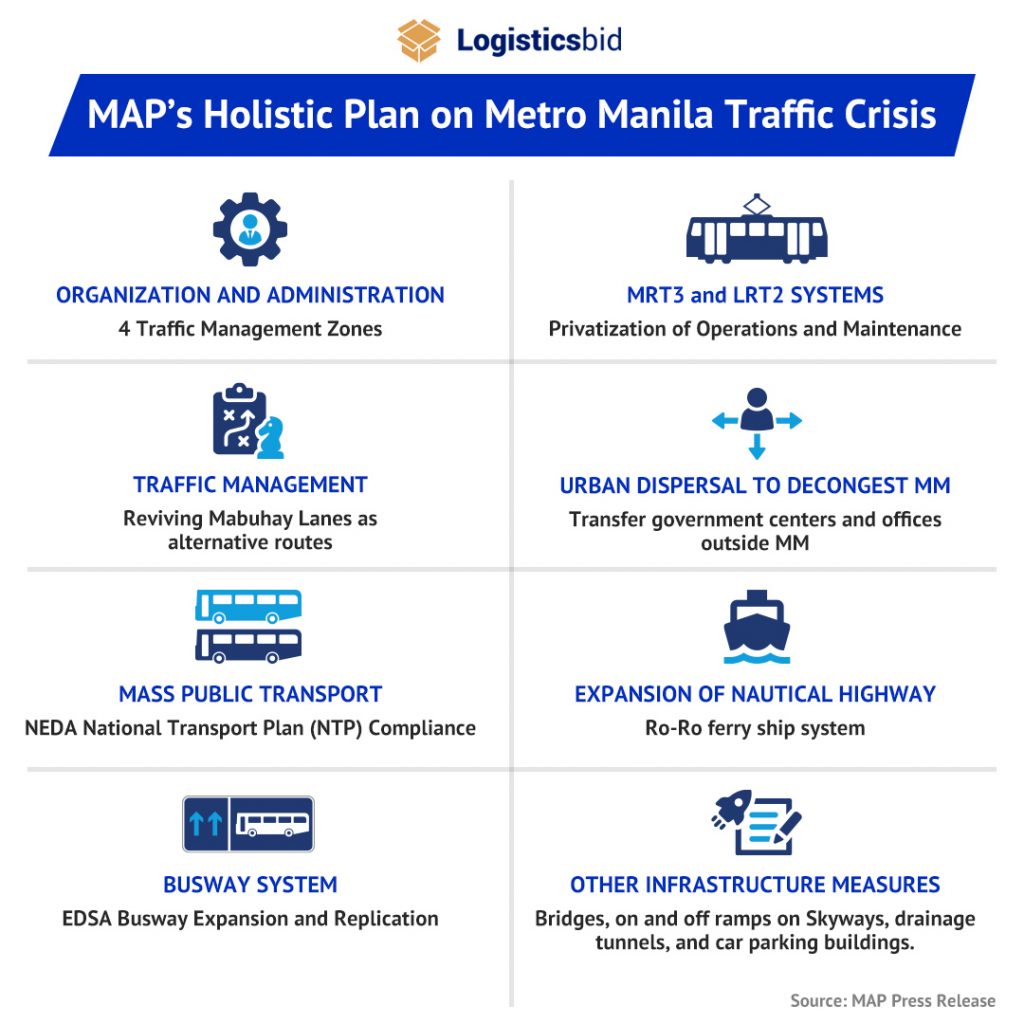
The problem of traffic jam, especially along Epifanio Delos Santos Avenue (EDSA) in Metro Manila, has long been a serious issue impacting thousands of daily commuters and the Philippine economy. The heavy traffic not only results in huge time losses but also worsens pollution and stress levels. Given the scale of the EDSA traffic situation, the Management Association of the Philippines (MAP) has put forward recommendations targeted at tackling the traffic crisis and improving the dire state of traffic along EDSA in particular.
Getting To Know the Longest Road in Metro Manila
Epifanio De los Santos Avenue, more commonly known as EDSA, is a major road in Metro Manila. It was originally built in 1939-1940 under President Manuel Quezon as part of a plan to improve road infrastructure connecting different parts of the capital region. EDSA was meant to link the new Quezon City, designated to be the Philippines’ capital, to the Manila airport in Makati. The thoroughfare was initially called “North and South Circumferential Road” and later “Highway 54” before being named after Epifanio De los Santos, a distinguished Filipino scholar, in 1959.
Running for 24 kilometers, EDSA arcs across the eastern side of Metro Manila, connecting Caloocan in the north to Pasay in the south. It passes through various cities like Quezon City, San Juan, Mandaluyong, and Makati. Given the geography of Metro Manila, the road serves as an important connector between northern and southern parts of the metropolis as well as the broader northern and southern Luzon regions.
Over the decades, EDSA has played a pivotal role in Metro Manila’s spatial development. It is lined with shopping malls, car dealerships, offices, hotels, government agencies, universities, and bus terminals. The road has become indispensable to the pulse of everyday life for Metro Manila residents.
EDSA Traffic Situation Update
According to the Metropolitan Manila Development Authority (MMDA), the EDSA traffic situation is now a never ending problem as Metro Manila topped the list for having 25 minutes and 30 seconds every 10 kilometers travel time. It increased by 50 seconds as compared to data from 2022 making it the slowest travel period in the world.
Growing populations and travel times
A 2019 Asian Development Bank study also cited in a Philippine House of Representatives report, that Metro Manila has the worst problem of traffic jam globally among cities of over 5 million residents. Metro Manila’s congestion level – which measures extra travel time during peak periods – stood at 1.5, drastically higher than the average of 1.24 across the 278 benchmark cities.
A congestion level of 1.5 signifies that travel times during peak hours are 50% longer compared to off-peak periods. Metro Manila placed well above other highly congested Asian cities like Kuala Lumpur, Yangon, Dhaka, Bengaluru, and Hanoi.
Growing number of vehicles on the road
The paper also noted that Metro Manila accounts for about 24.2% of the Philippines’ 12.7 million motor vehicle registrations. Of the capital’s 3.1 million vehicles registered in 2019, 47.8% were motorcycles and tricycles, 21.6% were utility vehicles, and 16.6% were cars.
Growing market for Delivery Apps
One of its causes is the growing markets for delivery apps like Angkas, MoveIt, Lalamove, and Transportify that drive more vehicles on the road for delivery and transport. It actually surpassed pre-pandemic levels for Philippine automobile sales in 2023, reaching 441,408 units sold. This exceeds the 423,000 unit forecast for the year by 18.93% compared to 2022. The category includes SUVs, MPVs, pickups, crossovers, trucks and buses. Mostly passenger car sales made up the remaining 25.16% at 111,039 units.
However, the report cautions that the EDSA traffic situation stems from more than high populations and vehicle density or insufficient roads. Solutions require recognizing the complexity of factors at play. Simply put, it is an intricate problem of traffic jam that needs coordinated policy responses rather than piecemeal measures.
MAP’s Call to Action on Problem of Traffic Jam

As an organization devoted to promoting management excellence and national development, the Management Association of the Philippines (MAP) believes urgent action must be taken to address the crippling traffic crisis in Metro Manila.
Recognizing this as a policy and management failure, MAP asserts that a paradigm shift is needed in the approach to urban road infrastructure and transportation. The group highlights the reality that road space is limited and must be utilized to transport people rather than prioritizing private vehicles. MAP’s position is that high vehicle occupancy and continuous traffic flow are key to effectively moving more commuters.
To support its stance, MAP points to the success of the Metro Manila Bus Rapid Transit System, more commonly known as the EDSA Busway. Despite only utilizing 550 buses, the dedicated bus lane has ferried substantially more passengers than the over 3,000 regular buses that previously jammed EDSA and failed to meet transportation needs. MAP sees this as clear validation that adding more roads and capacity for private cars is counterproductive and instead public mass transit done right eases congestion.
Calling out the problem of traffic jam, MAP urges decision-makers to take a holistic viewpoint focused on improved traffic policies, management, and enforcement. With the will to shift the transportation paradigm, MAP pushes for reforms to get Metro Manila moving again.
SEE ALSO: